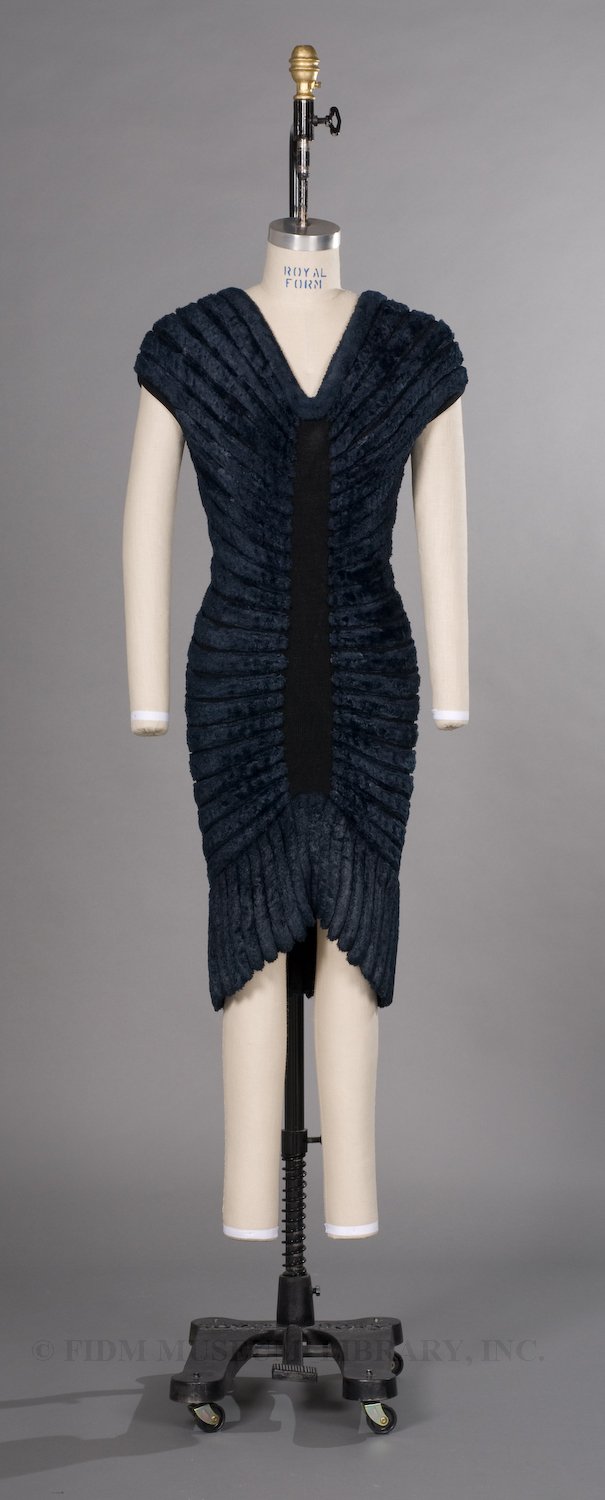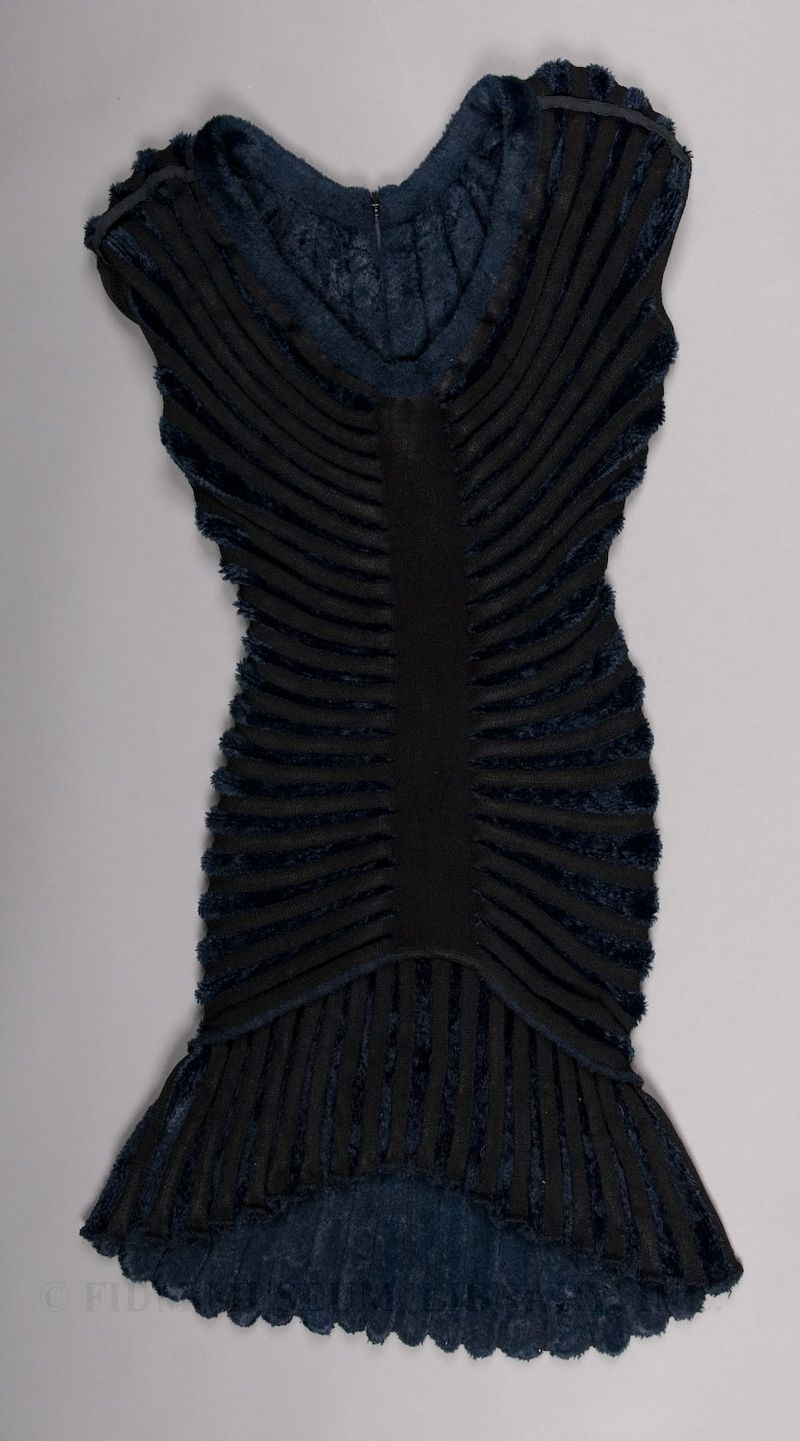Azzedine Alaia’s body conscious aesthetic earned him the title “King of Cling” and is closely associated with the 1980s. Throughout the decade, Alaia produced intricately seamed garments made of supple glove leather or stretch fabrics such as Lycra and silk
jersey. His most memorable designs fit the body like a second skin, providing a literal demonstration of his belief that “the base of all fashion is the body.”1 Almost all Alaia garments emphasize female characteristics such as hips, buttocks and breasts to the utmost degree, leading at least one fashion writer to accuse him of parodying the female body.2 Parody or not, the clinging fit of Alaia’s dresses and suits is usually displayed to best advantage on a curvy body. Alaia’s “curve consciousness” was credited with ushering in the era of voluptuous supermodels, such as Cindy Crawford, Paulina Porizkova and Naomi Campbell.

Dress of plush and stretch knit
Azzedine Alaia
c. 1991-1992
Gift of Nancy Riegelman
2006.602.1
Admittedly, the FIDM Museum dress form does not have the same allure as would a 1980s supermodel. Despite this, you can still see the crucial characteristics of the dress. With its alternate layers of plush chenille and stretch knit, the dress brings to mind the segmented body of a caterpillar or an undersea creature. The dark blue color and fishtail skirt reinforce this connection with the natural world, subtly suggesting the discarded shell of an insect or sea creature. When turned inside out, as in the image below, it more closely resembles a human ribcage.
Azzedine Alaia has been able to create a career in fashion on his own terms. He produces collections on his own timeline, unlike most designers who design and manufacture on a strict, retailer-dictated schedule. Alaia was able to gain this concession from retailers because his garments always sell. He does not stage elaborate fashion shows, preferring intimate presentations in his Paris workshop. Except for 2000-2007, when Prada owned a share in his company, Alaia has had no financial backers. He has also resisted the urge to license his name to revenue generating products such as perfume, preferring to concentrate his efforts on designing clothing rather than promoting his brand. Alaia’s ability to dance around the margins of the (often necessary) commercial aspects of fashion is a testament to his reputation and devoted following. As he stated in a interview in 2000, “women will never let me be forgotten.”3
1 McColl, Patricia. “Expanded Horizons for Azzedine Alaia.” New York Times 5 Sept. 1982: SM32.
2 Morris, Bernadine. “Azzedine Curves Cast Spell.” New York Times 1 April 1986: B8.
3 Horyn, Cathy. “Genius Has a Habit of Showing Up Every So Often.” New York Times 2 May 2000: B11.



wow love this blog and like the dress rokin
That’s craftsmanship! Beautiful. Wish I had the curves to pull off something like this.
I’ve always thought that this dress would “read” much better on a human body than it does on the dress form. So glad you were both able to see past the blocky dress form to appreciate the dress!
how could anyone accuse Alaia of “parodying the female body”? What does that make Jean Paul Gaultier?
I had always wondered how he produces his knit dresses. The ones I’ve seen at Galeries Lafayette look like the knit fabrics were custom-made for his designs (which would explain the price-tag). Like this dress for example, the inside looks so clean it’s almost wearable.
btw, “Gift of Nancy Riegelman” – author of 9 heads?
Elle,
The charge of parody was related to his extreme accentuation of the female form. To quote from the relevant article, “He believes his designs enhance a woman’s femininity, but too often he seems to indulge in parody.” (Bernadine Morris, NYT, April 1, 1986). My sense of the accusation is that Morris felt that his “enhancement” of a woman’s feminine charms reduced women to a caricature consisting solely of breasts, hips, and buttocks.
Gaultier’s emphasis on femininity has always seemed much more playful to me and not so much about being dead sexy.
Yes, the same Nancy Riegelman.